Rattan has come roaring back as the must-have texture in home décor. Long beloved by boho and coastal fans, this natural cane material now pops up everywhere – from farmhouse kitchens to Japandi bedrooms. Designers note that rattan has become a “stylistically versatile, long-lasting, and earthy, neutral grounding element” in any room. In other words, it works with almost any style. Whether as an oversized sunburst mirror or a sculptural wall panel, woven rattan instantly adds texture and warmth. As interior designer Ariel Okin puts it, “Rattan adds a lot of warmth since it’s a natural material with a lot of texture, so it’s a great material to add in when a space is feeling too sparse or cold”. That gentle, organic warmth is why designers are now bringing rattan into living rooms, bedrooms, nurseries, and even bathrooms. In fact, Maison & Objet trade-show coverage notes that by 2025 rattan “is back in all its tropical glory” and is showing up “in every room of the house”. It feels fresh and current, not just 1970s throwback – boho starburst mirrors and botanical wall shelves have become the new classics.
Living Room: Big Statements + Texture
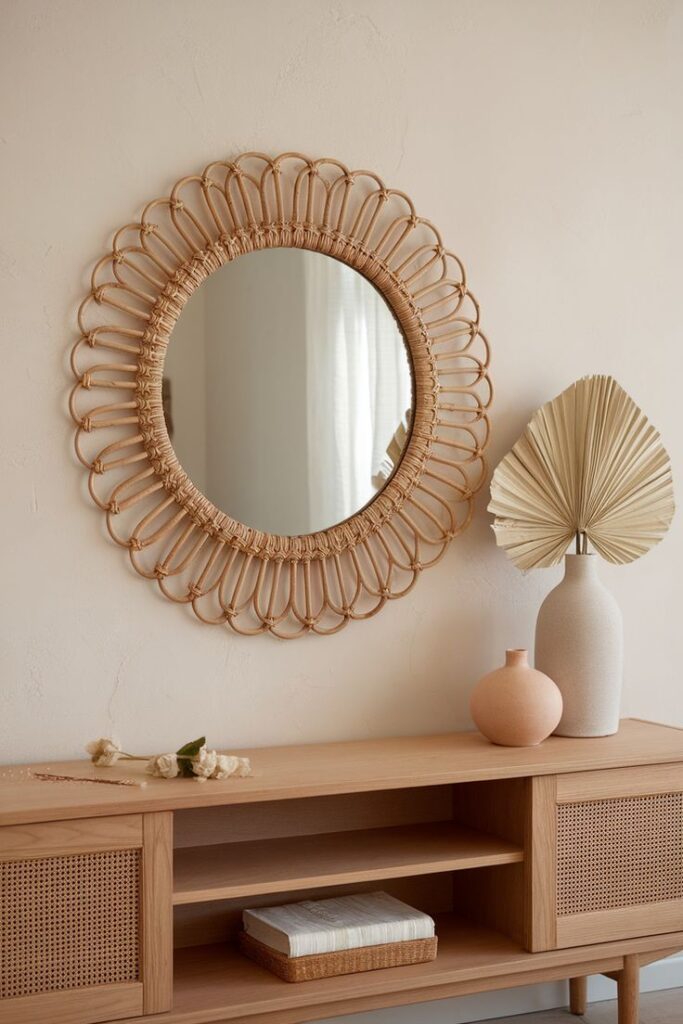

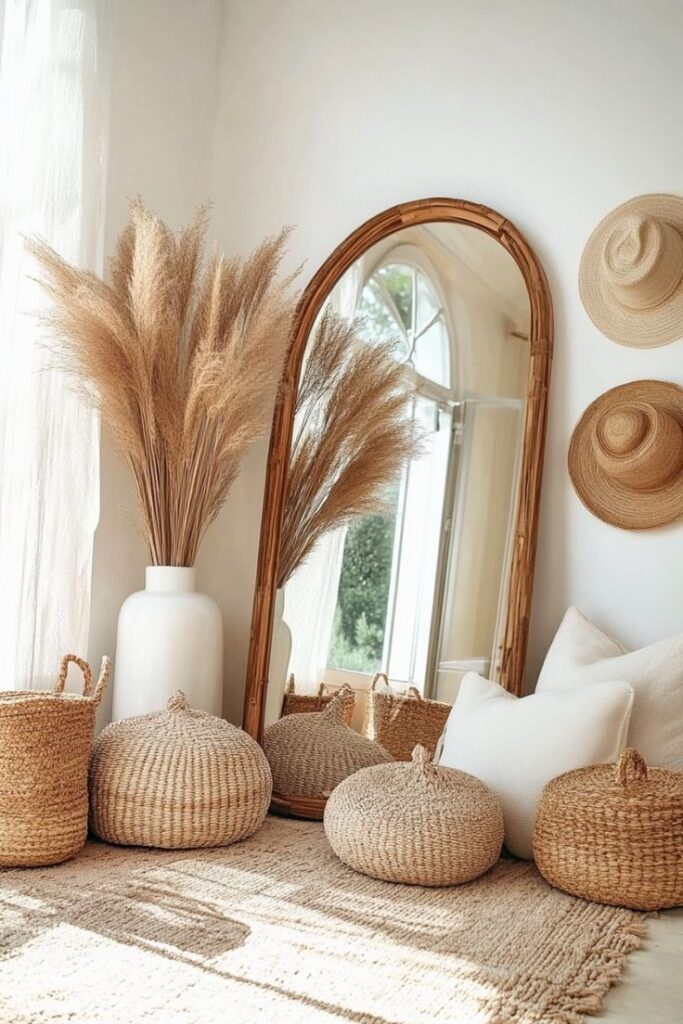
Imagine your living room anchored by a large rattan mirror or an intricately woven wall panel above the sofa. A round cane mirror – think of a sunburst or floral motif woven in golden rattan – can become the focal point of the room. Or try a gallery wall of mismatched oval and geometric rattan frames to add depth and interest. In a modern neutral space, these organic shapes break up flat walls and bring life. Designer Marina Hanisch warns that you don’t want too much rattan everywhere – “too much rattan can feel outdated” – but “the perfect dose can create a beautiful, organic contrast and add an effortless sense of ease to the overall design”. Just one oversized rattan round mirror, for instance, provides a needed curved edge against straight sofas and shelves. Or hang a sculptural rattan panel with a floral or wave pattern to echo houseplants, channeling a tranquil jungle vibe. The trick is to layer textures: pair that woven wall piece with a sleek fireplace or mid-century sideboard. Hanisch also notes that rattan’s handmade look makes a living room feel “curated and layered, rather than overly polished”. In short, a bit of rattan instantly softens a stiff formal space into something warm and collected.
In a coastal or tropical-themed living room, woven elements fit right in – perhaps a cane-framed art piece or a driftwood-inspired mirror. In contrast, Japandi or rustic-modern spaces use rattan’s earthy tone and clean weave as accents: think of a simple round mirror with a narrow rattan rim, hung above a minimalist console. Even minimal Scandinavian rooms can benefit from a rattan “sunrise” mirror, which adds a boho counterpoint without clashing. As Summer Thornton, an interior designer, says: “Rattan provides a great material contrast to more traditional upholstery or wood pieces. It gives a sense of lightness to primary rooms that feels fresh”. The woven shadows play in the sunlight, creating visual interest. On trend? Pair that mirror with a few macramé plant hangers or a jute wall hanging to double down on texture. The result is an inviting living room that feels travel-inspired and touched by nature.
Bedroom: Calm, Cozy Retreat
In a bedroom, rattan wall decor is all about serenity and warmth. Try hanging a large woven rattan headboard or an over-the-bed canopy frame in natural tones. A medallion mirror or two on either side of the bed – instead of the usual heavy framed mirrors – will bounce soft light. For a truly boho touch, look for hand-crafted rattan wall art in floral or mandala shapes: these pieces carry a gentle, artisanal vibe that makes the room feel lovingly personal. Wicker mirror panels or even vertical rattan panels flanking the bed can turn a plain wall into an elegant focal point.
Above a dresser or vanity, a rattan-framed mirror also works wonders. The straw-colored frame instantly brings an outdoor sense of calm indoors. In fact, Okin’s point about warmth rings especially true here: in a cool, modern bedroom, “a great material to add in when a space is feeling too sparse or cold” is rattan. You might also use a rattan wall shelf or ledge to hold framed photos or plants; it adds storage but also that beloved organic texture. Even small touches – say, hanging a tiny rattan basket or sunburst mini-mirror – go a long way in softening the space. If you prefer a clean look, keep the rattan a pale natural color. Thornton confirms, “I like to keep my rattan natural in color for a timeless and more elevated look”. A light tan or white-washed cane finish maintains tranquility and coordinates with white linens or muted walls.
For anyone chasing a “Japandi” (Japanese + Scandinavian) aesthetic in the bedroom, a rattan wall mirror or round decorative panel is the perfect blend of earthy and minimal. In a boho or eclectic bedroom, layer rattan pieces with plants and textiles in lively prints. No matter the style, the glowing cane fibers add an emotional layer of coziness: a woven wall piece can feel almost like a comforting quilt on the wall.
Entryway: Dramatic First Impressions
Don’t save the drama for the living room only – an entryway is the perfect spot for statement rattan art. Because the entry sets the tone for the whole home, consider a bold round sunburst mirror or a large floral cane design as soon as guests walk in. Picture a cane-framed mirror over a narrow console table, reflecting the entry lantern and a big leafed plant; the natural material immediately says “welcome home” with warmth. Or go for a vertical rattan panel (maybe with a carved motif or scalloped shape) on an otherwise blank wall, echoing patterns from outdoor wicker. Even a simple collection of hanging woven baskets or dreamcatchers can turn a foyer wall into a gallery of texture and culture.
These pieces also add function. A shallow woven shelf can hold keys or mail, and a round mirror is great for a last-minute outfit check. In the entry, that grounding is literal: a neutral rattan piece ties together any wall color or wood finish, giving an elegant yet laid-back vibe. In coastal homes, switch the typical framed mirror for one with a chunky rattan border; in contemporary homes, a more minimalist cane weave in a geometric pattern. The effect is the same – your entry feels curated, not contrived, and your decor hints at the earthy story unfolding inside.
Rattan “provides a … neutral grounding element in any room”. Apartment Therapy
Nursery or Kid’s Room: Sweet & Storybook
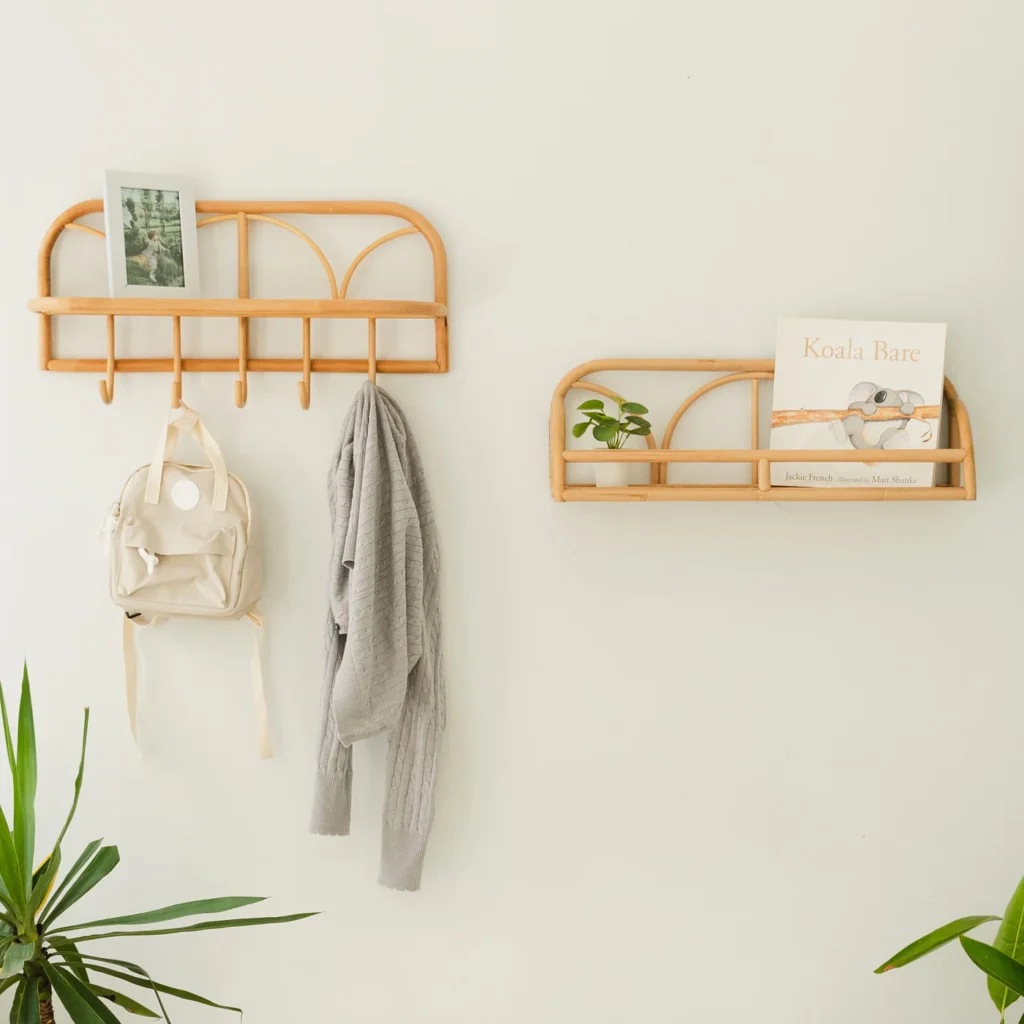
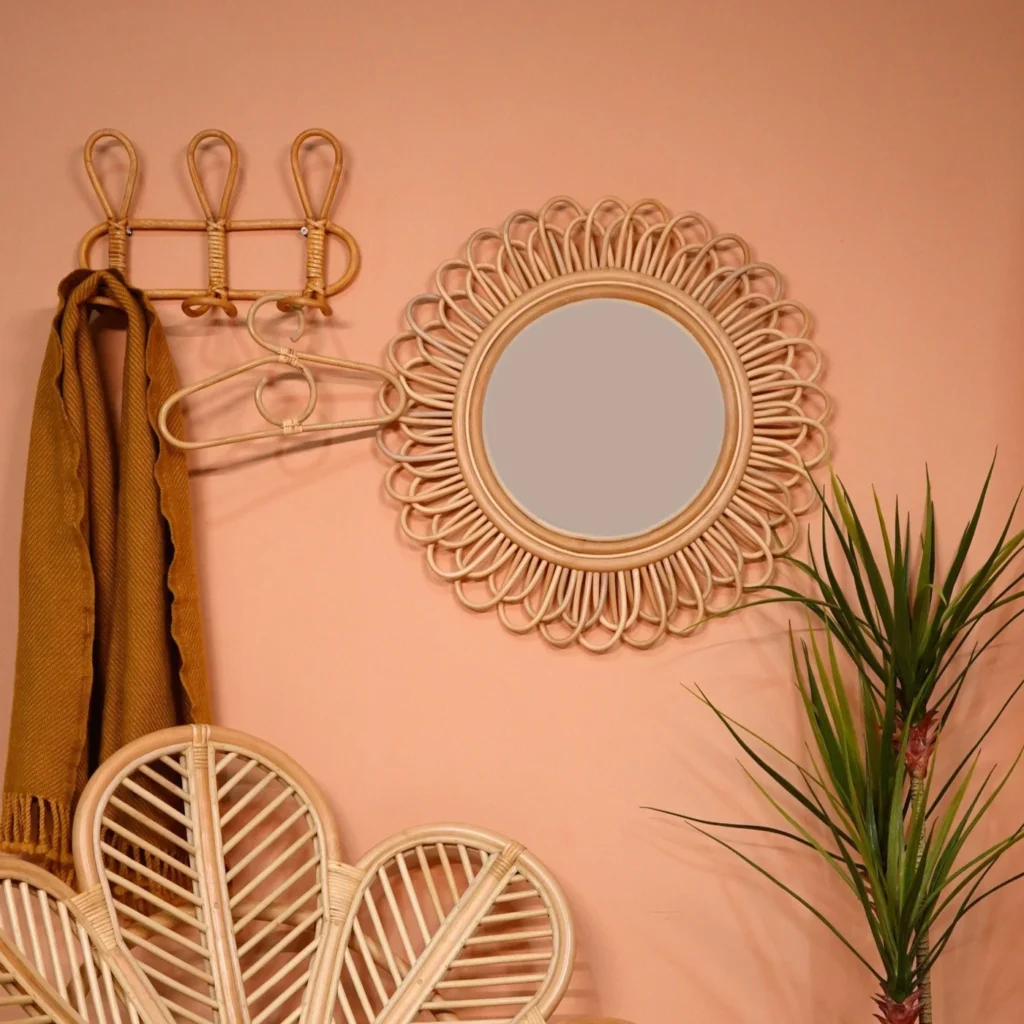

Rattan isn’t just for adult spaces. In a nursery or child’s bedroom, woven wall pieces can create a gentle, whimsical atmosphere. Think rattan animal heads (kids’ classics like elephants or dinosaurs) mounted on the wall, or a round “sun” mirror with rattan rays. Even a rattan shelf can add cheer above a changing table or bookcase. These pieces lend a soft textural element that feels handcrafted and personal – a far cry from plastic cartoon décor.
Designers of children’s rooms often mention that natural fibers add a sense of calm and authenticity. In bohemian style specifically, experts observe that using natural materials like rattan “adds warmth and authenticity to the space”. For example, a woven wall shelf could hold storybooks and plush toys, instantly warming up a nursery corner. In a nature-themed room, you might hang a large macramé butterfly with rattan details, or cluster small woven baskets in pastel hues. Because rattan is light and airy, it works well above dressers (leaving headroom) or along staircases in a kids’ hallway.
Just be mindful of safety: avoid anything with sharp edges, and secure wall art well. In a bathroom for kids, rattan should stay away from splashes, but a small woven basket for toiletries or a mirrored panel above the sink can add that same gentle texture to a spa-like kids’ bath. Overall, rattan elements in a child’s room bring a bit of the outdoors in – an organic touch that helps little ones feel grounded.
Bathroom and Beyond: Unexpected Warmth
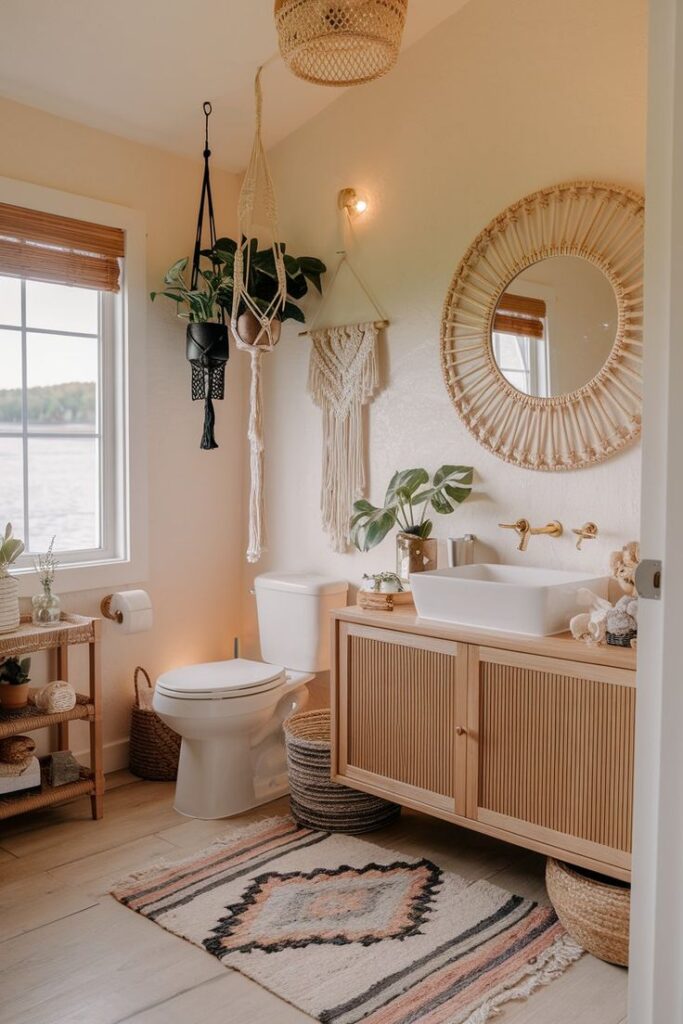
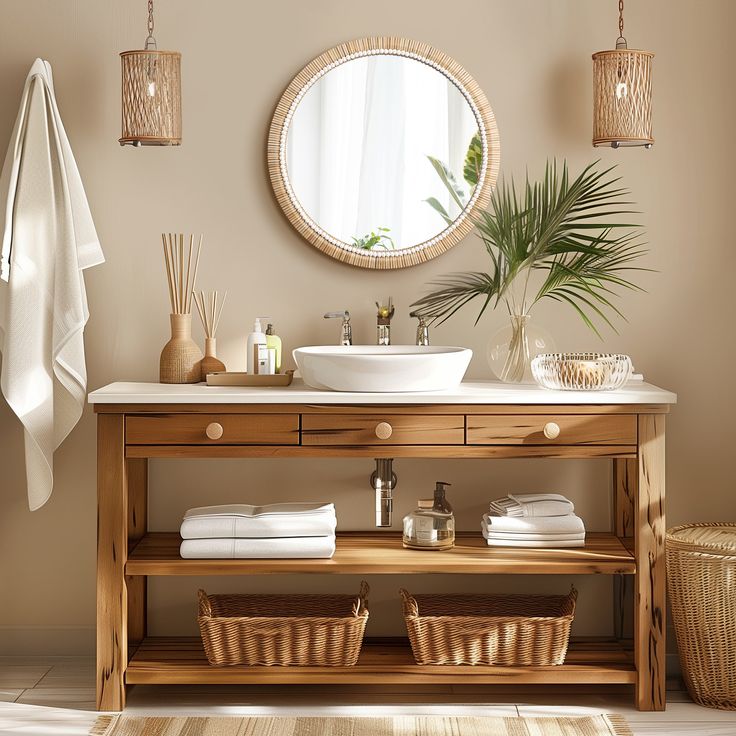

Rattan in a bathroom might sound risky, but a properly ventilated bath or powder room can handle it with style. Imagine a round rattan mirror above a white or marble sink – its cane frame instantly softens the cold tiles and chrome fixtures. Or install a narrow rattan shelf on the wall to hold plants or rolled towels; the woven pattern adds a spa-like, relaxed vibe. (Tip: use sealed or painted rattan pieces to guard against humidity.) Even a framed picture of palm leaves in a thick cane frame can add artful warmth over the tub.
In guest powder rooms, small rattan plaques or starburst motifs grouped on a wall can create a quirky focal point. Rattan wall sconces or pendant lights in a bath will also echo that cozy feeling (just ensure they are rated for damp areas). The overall effect is that even a utilitarian space feels more homey and storied.
Across all these rooms, one thing is clear: rattan wall decor isn’t a fleeting fad. It’s a versatile design language that resonates with our desire for nature, warmth, and craftsmanship. By mixing its organic weave with other materials – metal, glass, linen – rooms achieve a timeless balance. In the words of designer Amanda Reynal, “The key to making rattan feel fresh today is balancing its natural texture with crisp, colorful elements”. So pair your rattan shelf with a bright tile wall, or your woven mirror with a vibrant tapestry. The result is a layered, welcoming space where every glance at the wall tells part of your story.
